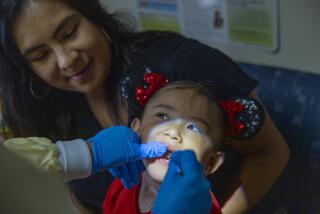You have to get braces? Cool
- Share via
Gone are the days when braces regularly provoked taunts of “tin grin” and “metal mouth.” Nowadays, braces are not only more accepted than ever — for children and adults alike — they’re often downright desirable.
“I think it’s become a rite of passage in some way in this society,” says Dr. Indru Punwani, professor and department head of pediatric dentistry at the University of Illinois at Chicago.
Between 1982 and 2008, the number of people getting braces in the U.S. leaped a whopping 99%, according to the American Assn. of Orthodontics. And adults are on the bandwagon. From 1989 to 2008, the number of adult patients getting braces rose by 24%.
“The stigma of being ‘too old’ for braces has diminished for the most part,” says Dr. Stephen Tracey, an orthodontist in Upland, Calif. “It wasn’t that long ago that adults considered orthodontic treatment ‘just for kids.’”
Orthodontists cite a host of reasons for the acceptance of braces. They’ve become more affordable, with insurance often covering part of the cost. The devices are more comfortable and less noticeable than in the past. Treatment is shorter, requiring fewer visits to the orthodontist. Society overall is recognizing the importance of oral health. And, of course, there’s an ever-increasing social pressure to look one’s best.
Braces are “faster, they’re sleeker, they’re smaller, they’re smoother, they’re just far more comfortable,” says Dr. Michael Rogers, president of the AAO. “I think from that standpoint, the public is just more willing to have the braces and more willing to go through the treatment.”
Dr. Lee Graber, an orthodontist in Vernon Hills, Ill., and past president of the AAO, would agree. He’s had orthodontic patients ranging from 3 to 88 years of age.
Not only are patients willing to start treatment well past adolescence, they’re also willing to assess their children’s need for treatment much earlier.
“We’re seeing more youngsters because more and more people are recognizing that orthodontics is a component of an oral healthcare program,” says Graber.
Braces, it seems, have no age limits.
Treating children
Orthodontic treatment for children sometimes occurs in two stages. Phase one, or early intervention orthodontics, begins around age 7 or 8 when children have gotten their first permanent teeth. Phase two begins when the permanent teeth are in, typically age 11-14; this is when the majority of kids get braces.
“Phase one is not so much to make the smile beautiful, it’s more to get the problems intercepted so that the jaws grow better and things function better,” says Rogers.
Reasons for early intervention include severe crowding of the teeth, pronounced overbite or underbite, jaw-growth discrepancies, and cross-bites, in which the upper teeth fail to overlap the lower teeth.
“Many times if you wait until the adult age to correct a cross-bite, it can involve a surgical procedure by an oral surgeon to free up the segments of bone, whereas if we correct them early, the bones are pliable, and it’s corrected easily and non-surgically,” says Rogers.
If children are not biting straight from an early age, orthodontia can alter their jaw development — another reason to begin in the 7 to 9 age range.
“Orthodontics can straighten the teeth up, but it can’t realign that lower jaw,” says Dr. Rhea Haugseth, a pediatric dentist in Marietta, Ga., and president of the American Academy of Pediatric Dentistry. “So you’ve got a skeletal discrepancy then. So if we see something skeletally wrong, we want to go ahead and fix it and try to get them into a more normal growth pattern.”
Orthodontists say that the benefits of braces for both children and adults can affect the health of teeth for a lifetime. Teeth are easier to clean when not crowded, and they wear evenly when properly aligned. Further, the treatment helps teach patients how to take care of their teeth.
“There’s an educational process that takes place at the same time that they’re going through corrective therapy,” says Graber.
Difficult decisions
In some cases, orthodontists must make close calls about putting braces on children, Graber says.
Occasionally he encounters moms who say that their daughter is embarrassed of her teeth and doesn’t want to smile at school. “She’ll say, ‘You know, four of her friends are getting braces right now. She thinks her teeth look funny and her friends are getting it taken care of; isn’t there anything you can do?’” says Graber. “You sometimes end up really having to talk to parents about what really is appropriate and normal.”
But he acknowledges that in rare cases, if a child’s self-image is hindering their development or causing them difficulties at school, it may be worth it to put braces on even if the treatment isn’t essential. “Sometimes it may be a very short period of treatment, and the psychological benefit certainly is worth it,” says Graber. “The mental is sometimes more important than the dental.”
In other cases, says Graber, “I’ve had kids leave in tears. I tell them, ‘You know, you really don’t need braces — you might need them later, but you really don’t need braces now.’”
“Usually when you tell them the reasons why you don’t want to do it, they value that opinion,” adds Graber.
Occasionally, orthodontists face pressure from kids or their parents to get braces. “I think there is pressure on parents from their kids and from parents to other parents, of the old ‘keeping up with the Joneses’ sort of thing,” says Ray Stewart, executive director of the California Society of Pediatric Dentistry. “It’s kind of a status symbol for kids to have braces now when they’re in the second and third grade.”
But Haugseth says that the number of cases of parents or kids thinking they need braces when they don’t is an insignificant number. And she says the same pattern occurs in reverse: “Do I see just as many kids who are hoping that they never have to have [braces]? Yes.”
“I practice in a more affluent area, so it might be more of a common misconception there that we’re putting them on for perfection,” says Haugseth. “I’m one that a little abnormality makes it look real. I’m OK with that completely.”
Adults opt in
Adults, too, are making tough decisions for themselves about whether or not to invest in braces, which are usually covered only in part by insurance. Braces typically run from $4,000 to $8,000, depending upon the treatment.
Many are opting for the clear and removable braces, which often are barely noticeable. More adults are in treatment now, says Tracey, “because they’re willing to go into orthodontics if they don’t have to look like they’re in junior high with headgear and crazy-looking braces.”
And the trend is contagious. “I’ve got one company — I must be treating almost everybody in that company because one gets it and another gets it and they just feel like it’s an acceptable thing to do,” says Rogers.
David Sweeney, a 48-year-old pilot for United Airlines based in Libertyville, Ill., just had braces removed after wearing the clear, glue-on brackets for a little more than two years. “A lot of people didn’t know I had braces,” says Sweeney. “They were surprised when I told them.” As Sweeney’s overbite improved, which shifted his jaw line, people began commenting that they thought he had lost weight, he recalls. But his weight hasn’t changed in five years, says Sweeney; rather, his improved bite had caused his face to appear slightly longer and thinner.
Even adults who had braces as children sometimes need to return for orthodontic treatment in midlife or later. Just as bone density decreases with age throughout our bodies, the bones in our mouths also lose density and shift with age. Many people do not wear their retainers as directed after treatment and find that their teeth eventually shift out of alignment.
“A retainer is to retain, to hold [the teeth] right where they are,” says Haugseth. “Now we know that you’ve got to retain them the rest of their life. Even my teenagers ask me, ‘Do I have to wear this forever?’ and I say, ‘Pretty much, if you don’t want anything to move.’”
Teeth also shift because of wear and changing pressures in the mouth, says Tracey, another reason why adults may end up needing braces regardless of whether they had them in their youth.
Tracey sees other adults opting for braces in order to enhance their competitiveness in the tough job market or because they are re-entering the dating scene after a divorce. “A beautiful smile contributes greatly to a person’s self-esteem,” says Tracey.
It takes time
Ultimately, however, some things haven’t changed in orthodontia. It’s still a process.
Meredith Keller, a mother of two in Ellicott City, Md., chose to have braces put on her son when he was beginning second grade, around 7 1/2, because he had buckteeth. “At the time, I was happy about it,” says Keller. “I thought, ‘Oh good, we’re getting this out of the way.’ It seemed like a good idea.” Her son wore the braces for just under a year.
But Keller says that she hadn’t previously considered the challenges of maintaining the correction. Her son was fitted with a retainer at the beginning of third grade. “That’s pretty young to be responsible for keeping track of one of these things,” says Keller. “And there’s a comfort issue, too.” He also ended up needing gum surgery to remove excess tissue on the top teeth, which required anesthesia.
“All these things came up that made me think maybe I should have waited.” All in all, Keller says she is happy with the results, but has been told that her son may need braces again in phase two.






